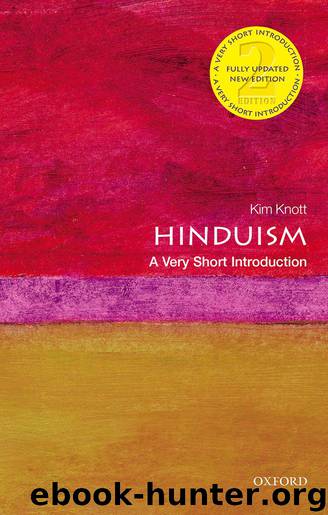Hinduism: A Very Short Introduction by Kim Knott

Author:Kim Knott
Language: eng
Format: epub
ISBN: 9780198745549
Publisher: OUP Oxford
Published: 2016-01-09T05:00:00+00:00
The European discovery of Hinduism
Europeans traded with India for spices and textiles as early as the classical and medieval periods, though perhaps the best known trader was the Portuguese Vasco da Gama who arrived on the Malabar coast at the end of the 15th century in search of ‘Christians and spices’. These two motives are indicative of what was to follow in later centuries: the European desire to see India in its own Christian image and judge it accordingly, and to benefit from its riches—its goods and its culture.
The arrival of the Portuguese was followed in the 16th and 17th centuries by the Dutch, British, and French, all of whom established trading companies. Of these, it was the British who strengthened their commercial and administrative position and came eventually to dominate India politically. From their base in Madras (now Chennai), the British East India Company secured Bengal by military force in 1757 and made Warren Hastings Governor-General in 1772. His period of office marked the intervention of the British Government in Indian affairs. Hastings is remembered as an administrator, but he was also important for his patronage of Sanskrit scholarship.
In this period, a number of books by Europeans were published about India and its religion. Many repeated the themes of earlier travel writing in which popular religion was abhorred and Hindu ethical and philosophical doctrines approved (though not always properly understood). From the 1770s, significant scholarly progress was made by men in the employ of the East India Company, most notably by Charles Wilkins, with the first English translation of the Bhagavad-gita (1785), and William Jones, with his Asiatick Researches (from 1789) including his translation of the Manusmriti. Both Sanskrit scholars presented the Hindu religion in a positive light, showing its antiquity and stressing the themes within it that a western audience could admire in their own terms. As Warren Hastings wrote in his recommendation of Wilkins’s Bhagvat-Geeta,
Download
This site does not store any files on its server. We only index and link to content provided by other sites. Please contact the content providers to delete copyright contents if any and email us, we'll remove relevant links or contents immediately.
Fingersmith by Sarah Waters(2406)
Kundalini by Gopi Krishna(2094)
Wheels of Life by Anodea Judith(1922)
The Bhagavad Gita by Bibek Debroy(1867)
Indian Mythology by Devdutt Pattanaik(1856)
The Yoga of Jesus: Understanding the Hidden Teachings of the Gospels by Paramahansa Yogananda(1752)
Autobiography of a Yogi (Complete Edition) by Yogananda Paramahansa(1739)
The Man from the Egg by Sudha Murty(1683)
Chakra Mantra Magick by Kadmon Baal(1588)
The Book of Secrets: 112 Meditations to Discover the Mystery Within by Osho(1588)
The Sparsholt Affair by Alan Hollinghurst(1509)
Avatar of Night by Tal Brooke(1451)
Sparks of Divinity by B. K. S. Iyengar(1450)
Karma-Yoga and Bhakti-Yoga by Swami Vivekananda(1437)
Gandhi by Ramachandra Guha(1435)
The Bhagavad Gita (Classics of Indian Spirituality) by Eknath Easwaran(1418)
The Spiritual Teaching of Ramana Maharshi by Ramana Maharshi(1373)
Hinduism: A Very Short Introduction (Very Short Introductions) by Knott Kim(1314)
Skanda Purana (Great Epics of India: Puranas Book 13) by Bibek Debroy & Dipavali Debroy(1306)
